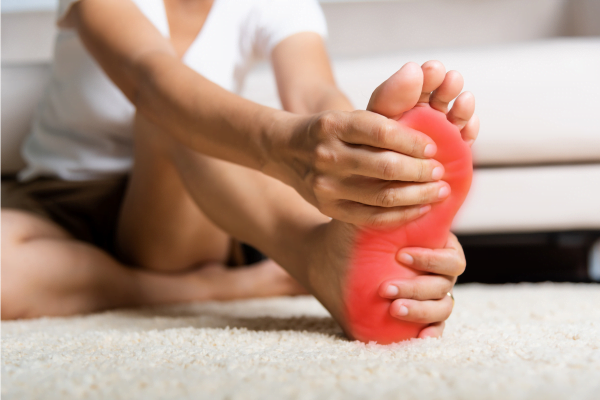Foot problems can escalate quickly in diabetes, and early action matters. Left untreated, diabetic foot ulcers may deepen, get infected, and raise the risk of hospitalization or amputation. This guide explains warning signs, causes, types, and treatment steps in clear language. It also outlines practical prevention and when to call a specialist.
Key Takeaways
- Early detection: Daily checks catch small injuries before they worsen.
- Multiple drivers: Nerve loss and poor blood flow often interact.
- Team care: Podiatry, wound care, and vascular input improve outcomes.
- Offloading: Reducing pressure is central to healing and prevention.
- Act fast: New redness, odor, or drainage needs prompt assessment.
Understanding Diabetic Foot Ulcers
Diabetic foot ulcers form when skin breaks down and fails to heal because of nerve damage (peripheral neuropathy), reduced circulation (peripheral arterial disease), and repetitive pressure. Neuropathy dulls pain and alters foot mechanics, so friction and microtrauma go unnoticed. Circulatory problems then limit oxygen delivery, slowing tissue repair and immune responses.
Clinicians often assess depth, infection, and blood flow status to guide care. Classification systems, such as Wagner or University of Texas grading, help stage complexity and support consistent decision-making. For a concise overview of grading and common terms, see Diabetic Foot Ulcer for ulcer basics and grading overview. This framing helps set expectations and clarifies the role of each care step.
Early Warning Signs and Stages
Look for subtle changes before an open sore appears. Hot spots, calluses over bony areas, shiny or thinned skin, and persistent redness suggest rising pressure. New drainage on socks, a foul smell, or undermined edges means the wound may be deepening or colonized. Numbness or tingling points to nerve loss, which increases injury risk and masks pain.
Common Diabetic Neuropathy signs—like reduced sensation in toes—explain why injuries go unnoticed, so build routine checks. Typical diabetic foot ulcer symptoms include localized redness, swelling, warmth, and drainage that persists beyond a few days. Schedule regular Foot Screening For Diabetes visits for a preventive exam checklist that can catch problems early. Understanding the healing stages of foot ulcers helps you recognize progress or setbacks.
Causes and Risk Factors
Several factors act together to initiate breakdown. The most important causes of diabetic foot ulcer are neuropathy, high plantar pressure from deformities or tight footwear, and impaired arterial flow to the foot. Smoking, chronic kidney disease, and poor glycemic control further slow wound repair. Prior ulcers or amputation increase recurrence risk substantially.
Circulation problems often limit oxygen delivery to tissue. If calf cramps with walking or cold, pale feet occur, ask about a vascular assessment. See Peripheral Artery Disease And Diabetes for blood flow risk factors and testing approaches. Addressing footwear fit, toe deformities, and callus management reduces repetitive trauma and lowers recurrence.
Types and Differential Diagnosis
Clinicians generally describe neuropathic (pressure-driven), ischemic (blood flow–limited), and neuro-ischemic (mixed) wounds. Location and appearance provide clues: neuropathic ulcers often sit under metatarsal heads or the great toe; ischemic ulcers may occur at the margins of the foot or heel with punched-out edges. Mixed ulcers show features of both categories and usually heal more slowly.
Understanding the main types of foot ulcers helps with shoe selection, pressure relief, and referral. Also consider conditions that mimic or complicate ulcers, such as bullous skin disorders, gouty tophi, or infection spreading through skin layers. Review Cellulitis And Diabetes to recognize spreading skin infections and when antibiotics are needed. For blistering differentials, see the Diabetic Blisters Guide for non-ulcer causes that still require protection.
Treatment and Care Pathway
Evidence-based diabetic foot ulcer treatment includes debridement (removing dead tissue), infection control, offloading, moisture-balanced dressings, and optimizing circulation and glucose levels. Offloading devices—such as total contact casts or removable walkers—reduce pressure on the wound so new tissue can form. When blood flow is limited, vascular evaluation and possible revascularization can improve healing chances.
High glucose impairs immune function and collagen formation. Nutrition, smoking cessation, and comorbidity management support tissue repair. For background on how blood sugar affects healing biology, see Diabetes And Wound Healing to learn how glucose affects repair. Team care is key; consult a foot specialist when wounds stall. For role definitions, visit What Is a Podiatrist for specialist roles in foot care.
Offloading and Wound Care Essentials
Offloading means moving pressure away from the ulcer site so granulation tissue can develop. Total contact casting is often considered the gold standard for forefoot and midfoot lesions because it enforces adherence and redistributes weight across the entire plantar surface. Removable cast walkers can also work, but only if worn consistently during all waking hours.
Dressings should maintain a moist environment without macerating surrounding skin. Options range from foams and alginates to hydrofibers and antimicrobial dressings. Frequent debridement can reduce bioburden and stimulate healing by converting a chronic wound into an acute one. Ask providers about gait changes, rocker-soled shoes, or custom orthoses to prevent recurrence once the wound closes.
Antibiotics and Topicals
Not all ulcers need antibiotics; use depends on clinical signs of infection such as redness extending beyond the wound, warmth, swelling, pain, or purulent drainage. Culture-guided therapy helps target likely organisms, especially in moderate to severe infections or prior antibiotic exposure. Appropriate diabetic foot ulcer treatment antibiotic selection should follow local resistance patterns and clinical guidelines.
Topical antiseptics and modern dressings may reduce bioburden, but systemic therapy is for true infection. Fungal skin disease between toes can worsen moisture and maceration. For athlete’s foot management when present, see Terbinafine for reducing recurrent skin breakdown around ulcers. For guidance on when to use systemic therapy, review widely cited clinical guidelines; they outline infection severity and antibiotic choices.
Complications, Amputation, and Outcomes
Deep infection, osteomyelitis (bone involvement), and critical ischemia can lead to hospitalization and surgical procedures. Prompt treatment may limit tissue loss and preserve mobility. Discuss limb-salvage options early, including revascularization and advanced wound therapies. Multidisciplinary care can reduce length of stay and reoperation risk, while coordinated follow-up lowers recurrence.
Overall diabetic foot ulcer mortality rate remains high compared with many cancers, especially when amputation occurs. For context on long-term outcomes, see a research summary describing excess cardiovascular and infection-related deaths after ulceration. For patient-focused foot care basics, the CDC provides practical foot care tips that reinforce inspection and protection strategies.
Prevention and a Self-Care Plan
An effective diabetic foot treatment plan starts with daily habits. Inspect soles and between the toes every night using a mirror if needed. Wash and dry thoroughly, especially between toes; moisturize dry skin but avoid applying lotion to macerated areas. Choose cushioned, well-fitting shoes and replace worn insoles. Break in new footwear gradually to avoid pressure points.
Keep toenails trimmed straight across, and address corns or calluses with professional help. Control glucose, blood pressure, and cholesterol to support healing capacity. For practical routines that support glucose targets, see Managing Type 2 Diabetes for small, sustainable changes you can adopt. Build a personalized prevention schedule with your clinical team and revisit it after any footwear or activity changes.
When to Seek Specialist Help
Contact your healthcare team urgently for new warmth, redness spreading beyond the wound, foul odor, fever, or rapidly increasing drainage. Also seek help if you notice sudden color changes, rest pain in feet, or an ulcer that fails to shrink after several weeks of consistent offloading. Early imaging may be needed to rule out bone infection when pain escalates or when probing reaches bone.
Plan regular visits with a podiatrist, especially after an ulcer heals. Ask about vascular evaluation if pulses are weak or if walking distance is limited by calf pain. For broader education on diabetes complications and prevention, visit our Diabetes collection for broader disease education and monitoring strategies.
Recap
Foot ulcers in diabetes arise from nerve loss, pressure, and poor blood flow. Early recognition, offloading, and infection control support healing. Multidisciplinary care and strong prevention habits lower complications and enhance mobility. Build a plan, check your feet daily, and act quickly when warning signs appear.
Tip: Keep a simple foot log. Note shoe changes, hot spots, drainage, or new redness to track trends and prompt timely care.
This content is for informational purposes only and is not a substitute for professional medical advice.



